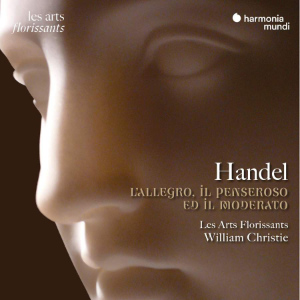
George Frideric Handel (1685 – 1759)
L’Allegro, il Penseroso, ed il Moderato HWV 55 (1740)
Rachel Redmond (soprano), Leo Jemison (Trinity Boys Choir) (boy soprano), James Way (tenor), Sreten Manojlović (bass-baritone)
Chœur et Orchestre des Arts Florissants/William Christie
rec. 2022, Philharmonie de Paris
Sung texts with French and German translations enclosed.
Reviewed as download from press preview.
Harmonia Mundi HAF8905359/60 [2 CDs: 101]
“L’Allegro, il Penseroso ed il Moderato is perhaps Handel’s most mysterious work” writes Emmanuel Resche-Caserta, concertmaster of Les Arts Florissants, in the foreword to this issue, and continues: “In the first place, it is difficult to categorise: a hybrid composition, somewhere between oratorio, ode and serenata, with a philosophical and moral purpose, it is devoid of dramatic action and its protagonists are two allegorical figures, L’Allegro and Il Penseroso, drawn from Milton’s eponymous poems as adapted by the composer’s contemporary Charles Jennens.” Jennens two years later also wrote the libretto for Handel’s most famous work: Messiah. After some further expounding, Emmanuel Resche-Caserta poses a question: “… how can we convey a message to the audience when there is no story to tell, as in dramatic works, or religious feeling to exalt?” He gives the answer himself: “It is Handel himself who gives us all the keys to achieving this, through his ability to paint each of Milton’s (and Jennens’s) words in a score of great stylistic variety.” To sum things up drastically: “The soloists, our choir and our orchestra of Les Arts Florissants are transformed into a painter’s workshop, a veritable bottega, under the direction of William Christie, to bring this demanding score to life.” I interpret this as a suggestion to the listener to forget searching for any underlying meaning of this music. The flavour of the words and the music constitute a symbiosis that has a value in itself. L’art pour l’art as Théophile Gautier and others expressed it in the early 19th century. I have more than once maintained this attitude towards music-dramatic works with poor librettos, say many of Johann Strauss’s operettas, besides those that actually are performed. In all of them there are a few, maybe more, numbers that turn out to be attractive just as melodies and because the scoring is professional.
Concerning Handel’s vocal works there are always hidden gems that are just waiting to be explored, and L’allegro is certainly a goldmine. Many of the individual numbers have also been performed and recorded through the years. The most famous is no doubt the big soprano aria from the first part Sweet bird, that shun’st the noise of folly (CD 1 track 13) with a spectacular part for flute, in practice a duet with the soprano. As early as 1904, in the very infancy of the gramophone record, Nellie Melba set it down – and that is indeed a historical classic. Many a soprano has followed in her footsteps, like the Austro-Hungarian coloratura soprano Maria Ivogün in 1925. Among later names can be mentioned Elisabeth Schwarzkopf and Kathleen Battle, neither of them Baroque specialists. Rachel Redmond on the present recording may not be quite in the same division as those mentioned above, but she sings delectably anyway and sports a beautiful trill – and Serge Saitta’s handling of the flute solo is expert. There are several other soprano arias to savour, like the very beautiful Hide me from day’s garish eye (CD 2 track 7) and in the third part the lively Come, with gentle hand restrain (CD 2 track 18). She also sings in the only duet, As steals the morn upon the night (CD 2 track 21), a great favourite of mine and one of the most beautiful vocal numbers by Handel, or any other Baroque composer. Here she is partnered by tenor James Way, who also has some solos on his own. The aria with chorus, These delights if thou canst give (CD 2 track 10) is brilliant, and in part 3 Each action will derive new grace (CD 2 track 20) is even more so. The bass soloist has less to sing, but the dancing Mirth, admit me of thy crew (CD 1 track 15) is a highlight. Sreten Manojlović hasn’t the most ingratiating of voices, but he is expressive enough, and the opening recitative with the aria Come, with native lustre shine (CD 2 track 15-16) of part 3 is another piece worth a listen. Last, but not least, I want to applaud the eminent boy soprano Leo Jemison, whose clear and beautiful voice is heard in several excellent solos.
To return to “the painter’s workshop”, mentioned in the first paragraph, it is really interesting to note Handel’s subtle use of orchestral colours, not only in the obvious allusions to the texts – the flute in Sweet bird, the horn solo (CD 1 track 15), where the text says “To listen how the hounds and horn/Cheerly rouse the slumb’ring morn”, “Or let the merry bells ring round,/And the jocund rebecks sound” (CD 1 track 19) and “There let the pealing organ blow/To the full voic’d quire below” (CD 2 track 12), but also more sophisticated usages. The woodwind scoring with oboe and bassoon in the duet “As steals the morn upon the night,/And melts the shades away” (CD 2 track 21) is truly magical, to give one isolated example. But it is a fascinating experience to explore the score from this point of view.
It goes without saying that William Christie and his choral and orchestral forces execute all these subtleties to perfection, bearing in mind that they have worked together since 1979. I have not made direct comparisons with other existing recordings – there are at least a good half-dozen with McCreesh and Gardiner as top contenders – but Christie can firmly stand by their side.
Göran Forsling
Help us financially by purchasing from




















